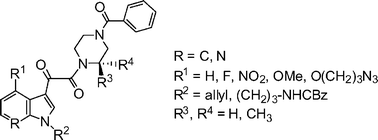Modification and structure–activity relationship of a small molecule HIV-1 inhibitor targeting the viral envelope glycoprotein gp120
Abstract
This paper describes selected modification and structure–activity relationship of the small molecule HIV-1

* Corresponding authors
a
Institute of Human Virology, University of Maryland Biotechnology Institute, University of Maryland, 725 W. Lombard Street, Baltimore, MD, USA
E-mail:
wangx@umbi.umd.edu
Fax: 410-706-5068
Tel: 410-706-4982
This paper describes selected modification and structure–activity relationship of the small molecule HIV-1

 Please wait while we load your content...
Something went wrong. Try again?
Please wait while we load your content...
Something went wrong. Try again?
J. Wang, N. Le, A. Heredia, H. Song, R. Redfield and L. Wang, Org. Biomol. Chem., 2005, 3, 1781 DOI: 10.1039/B415159C
To request permission to reproduce material from this article, please go to the Copyright Clearance Center request page.
If you are an author contributing to an RSC publication, you do not need to request permission provided correct acknowledgement is given.
If you are the author of this article, you do not need to request permission to reproduce figures and diagrams provided correct acknowledgement is given. If you want to reproduce the whole article in a third-party publication (excluding your thesis/dissertation for which permission is not required) please go to the Copyright Clearance Center request page.
Read more about how to correctly acknowledge RSC content.
 Fetching data from CrossRef.
Fetching data from CrossRef.
This may take some time to load.
Loading related content
